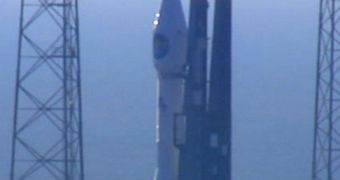After the first canceled launch attempt yesterday, experts managing the new NASA Solar Dynamics Observatory (SDO) were counting on better weather conditions today for launch, and they got them. With wind speeds at the pad just below the 20-knot limit, the newest telescope of the American space agency had a “go” for launch, and take-off occurred at 10:23 am EST (1523 GMT), as planned. The Atlas 5 rocket carrying the precious payload – a part of the “Living With a Star” program – roared from its pad, at the Cape Canaveral Air Force Station (CCAFS), in Florida, in cheers, Space reports.
“The SDO spacecraft is headed to an orbit about 22,300 miles above Earth. From that altitude, the spacecraft will point its instruments at the Sun and relay the readings instantly to a ground station in New Mexico. The research is expected to reveal the sun's inner workings by constantly taking high resolution images of the sun, collecting readings from inside the sun and measuring its magnetic field activity. This data is expected to give researchers the insight they need to eventually predict solar storms and other activity on the sun that can affect spacecraft in orbit, astronauts on the International Space Station and electronic and other systems on Earth,” NASA said in a statement.
“To the naked eye, the sun appears as a constant pale yellow ball. SDO is designed to probe solar variability. It will revolutionize our view of the Sun,” Madhulika Guhathakurta, who is an SDO project scientist at the NASA Headquarters, in Washington DC, said on Tuesday. Using instruments that will provide a resolution ten times better than HD, the $850-million observatory will spend the next five years collecting streams of data on the hidden variability of the star in extreme ultraviolet wavelengths, which it will then immediately relay to listening and tracking stations on Earth. The SDO has sufficient fuel to last in orbit for at least a decade, if enough funding for the mission is secured.
“Our Sun affects our lives more and more as we depend more and more on technology. We would like to predict this magnetic field, to predict what's going to happen in solar activity and to say a solar flare is coming,” Goddard Space Flight Center (GSFC) expert Dean Pesnell, who is also a project scientist for the new mission, added. “We can't wait to get this data started,” Elizabeth Citrin, who is the GSFC SDO project manager, shared.
In order for it to be able to conduct its investigations, the telescope will feature three scientific instruments, especially designed for solar observations. The first is the Helioseismic and Magnetic Imager (HMI), whose job is to make maps of the plasma flows that generate the star's magnetic fields. It is also in charge of mapping the magnetic fields themselves. The second instrument is the Atmospheric Imaging Assembly (AIA), which will use multiple wavelength filters to image the solar atmosphere, from infrared to ultraviolet. The HMI/AIA collaboration will link internal changes to external effects.
The third and final instrument is the Extreme Ultraviolet Variability Experiment (EVE), whose job is to measure the Sun's radiation emission levels in the extreme ultraviolet wavelengths (EUV). While, in visible light, the star shows little changes in its brightness, variations become very visible in this portion of the electromagnetic spectrum. Researchers want to take a better look at the star using this knowledge.

 14 DAY TRIAL //
14 DAY TRIAL //